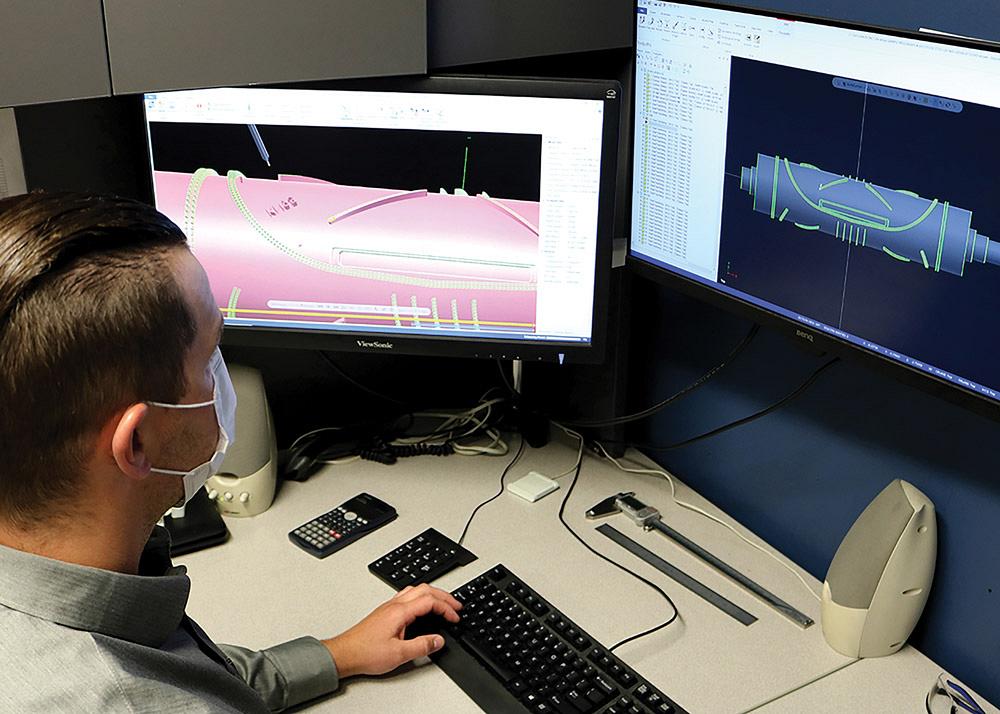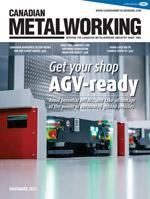Manufacturing Technology Writer
- FMA
- The Fabricator
- FABTECH
- Canadian Metalworking
Eclipse Automation uses advanced CAD/CAM to combat COVID-19
Ontario manufacturer partners with biomedical firms from Toronto to Tucson to Tokyo to develop and launch products
- By Chris Taylor
- December 8, 2021
- Article
- Health & Safety

Mastercam simulation on the left screen shows the stock model used to check program accuracy. The right screen shows the Mastercam programming interface, model, and the toolpaths used to machine the roller.
The COVID-19 global pandemic has been a major disrupter to life as we know it and has laid the groundwork for a “new normal” in every aspect of society.
The virus demanded people, products, and services make a big pivot to doing things in unfamiliar ways. It stretched our capabilities and our resolve, and the world engaged in warfare against an invisible and deadly enemy.
Many sectors were tested, but none like health care and life sciences. Hospitals were flooded with COVID patients, and the demand for personal protective equipment (PPE) and lifesaving medical devices and hardware skyrocketed with the rocketing number of admissions.
Around the world, companies and cities adapted to the need. Auto manufacturers made life-supporting ventilators, whisky distilleries made hand sanitizer by the barrel, and civic centres and sports arenas became makeshift hospitals and mass vaccination centres.
As an example here in Canada, Eclipse Automation, Cambridge, Ont., heard and answered the call and rallied its more than 800 global employees in Canada, the U.S., and Europe. It called upon two decades of experience in custom automation and manufacturing to meet the exponential demands for PPE and point-of-care COVID-19 diagnostic testing devices and materials, partnering with biomedical manufacturers from Toronto to Tucson to Tokyo to develop and launch products and procedures to fill the rapidly widening gaps.
Worldwide Help
Established in 2001, Eclipse builds custom automated manufacturing equipment for a variety of sectors, including life sciences, energy, transportation, consumer, electronics, and industrial. The company has facilities in Cambridge and Stratford, Ont.; Rock Hill, S.C.; Mesa, Ariz.; Veszprem, Hungary; and Zurich, Switzerland. It leaned heavily on Mastercam CAD/CAM software from CNC Software Inc., Tolland, Conn., to keep lines of precision machinery running as it ramped up its manufacturing output to near around-the-clock operations.
“At the start of the pandemic, we were running 20 hours per day, seven days a week,” said Ryan Szusz, Eclipse Automation’s machine shop supervisor. “We are doing blood testing kit lines, rapid test kit lines for multiple companies, and a variety of different mask lines. We have six or eight different mask patterns and we run three defined masks: surgical masks and two styles of N95-equivalent respirators.”
Eclipse Automation was a founding member of the Canadian Association of PPE Manufacturers, formed in the early days of the COVID-19 crisis, when Canada realized its supply of protective equipment was perilously low.
In addition to manufacturing PPE, the company makes two different Health Canada-certified respirators and, as of April 2021, has the capacity to produce approximately 130 million units of PPE each year, including 80 million respirators and 50 million surgical masks.
Manufacturing Expertise
Eclipse’s specialty is building automation systems for some of the largest manufacturing firms in the world, and the pivot to designing and fabricating N95 and surgical face masks was both a patriotic and humanitarian act. It can now produce tens of millions annually inside its Cambridge facility alone.
PPE face masks demand precision manufacturing techniques and equipment. Eclipse worked with partner Harmontronics Automation Technology Co. Ltd., Suzhou, China, to make machines to manufacture the two levels of masks in global demand -- the N95-equivalent respirator mask used primarily by health-care and first-responder professionals and the surgical procedure masks used by just about everyone else.
“Harmontronics already had some of the technology for the mask lines and we added the extra value of bringing it to North American standards as well as troubleshooting and technical skills,” Szusz said. “Through our machine tool builder integrators, we got it done. They have a strong knowledge of pneumatics, electronics, and mechanics. They are the guys that worked the magic on the machines for us to hit the rates that our customers require.”
Eclipse Automation used Mastercam to program the side-wall axial relief feed (Swarf) toolpaths to control the machining rollers used to cut the mask material and ultrasonically weld it together. Swarf uses the side of the tool for machining and leaves a smooth finish without stepover or stepdown marks, the manufacturer reports. The toolpath now has separate feed rate control options for entry and exit linking moves. The Swarf strategy supports Contours and Surface modes.
“The cutting roller is just like a printing press,” Szusz explained. “For every rotation of the double-sided cutting roller, two masks are produced. One roller is completely cylindrical, the other has the cutting surfaces. When you put enough tension between the two with the material, it cuts the pattern of the mask you need. As it moves through the line, it moves to the ultrasonic welding rollers where it bonds the three or more layers of material together. The Swarf toolpath is on a vertical machining centre with a rotary fourth axis, and we are doing the fine, serrated cutting edges or ultrasonic welding edges that make the mask pattern.”
Making critical medical devices like N95 masks brings its own stringent requirements.
“Medical device manufacturing requires primarily stainless steel,” said Szusz. “Because we can’t have any chance of contamination, we do a lot of 304 stainless. Using Mastercam’s Dynamic Milling to even-face stainless steel parts gave us an edge where we could achieve really long tool life, and we could keep the stress out of the stainless steel by running Dynamic Milling and still achieve a good cycle time.”
Holding Tight Tolerances
“We’re holding a tolerance of about a 0.001-in. flat nest across 8 by 2 in. by about 10 mil thick at the final part size,” explained Team Lead Corby Karpowicz. “We start with 3/4-in. bar stock on thickness. It has a lot of nesting features—tight corners—so we typically just go in with the high-speed steel drill, blast out the corners, and try to use the bigger end mill and step it down.”
The pockets are roughed with a 1/4-in. end mill. Karpowicz can machine upwards of 100 IPM with a 5 per cent radial stepover at a 1/2-in. DOC. From there he uses a 1/8-in. end mill at 130 IPM to pick out the corners. He can go down as small as a 1/16-in. end mill.
As he reduces end mill diameter, he bumps up his RPMs and feed rates, so he can push the 1/16-in. end mill to 200 IPM with a 0.005- to 0.006-in. feed per tooth.
“I’m trying to figure out the most rapid, efficient way to remove material without having cutter failure,” Karpowicz said. “A lot of what I’ve done is trial and error based on our end mills. We are always trying to push the envelope and try new toolpaths and new ways of removing material to keep up with cycle times.”

A 4th-axis rotary head with live tailstock centre is used to machine curved ribs across the ultrasonic mask line roller.
As a machinist gets into smaller diameters and the flutes on his end mills get tighter, he can feed faster and faster, added Szusz. Machining has fewer interruptions, creating constant spindle load. Because Dynamic Motion technology uses the entire flute length of cutting tools, air cutting is minimized or eliminated, tool life is extended, and cycle times are reduced.
Eclipse’s fully automated N95-equivalent respirator mask lines are equipped with ultrasonic welding technology and material feeding and finished product unloading, all automated. With features like automatic fabric roll feeding, nose clip, mask body ultrasonic roller welding, label pad printing, ear-loop welding, sponge nose pad assembly, folding, die cutting, finished product unloading, and scrap material removal, one operator can manage multiple lines simultaneously. Eclipse’s ear-loop surgical mask assembly line is also automated, enabling a single operator to run multiple lines. Outsourcing is popular among other manufacturers, but not for Eclipse.
“Eclipse has made an extremely large investment in manufacturing when a lot of companies are sending their work overseas,” Szusz said. “We bought a building on the neighbouring street and moved our machine shop. It’s a larger facility. Last year we bought nine new CNC machines. This year we bought another five. It brought us into the 21st century instead of running some of the machines that were 15 or 20 years old. Most of our machines are 6 years old or newer.”
The Challenges
Szusz said COVID even challenged the way day-to-day was done—everything from social distancing to the raw materials supply chain.
“The largest challenge I found was related to the fact that we run multiple shifts,” he said. “We’re sharing common tooling and machines and we still have to adhere to all the COVID protocols. Keeping up with the sanitizing and maintaining social distancing was a larger challenge than ramping up the machining because traditionally you pack as many machines into a shop as you can. And it doesn’t necessarily place you at the recommended 2-m distancing.”
In general, Eclipse Automation takes on challenges that many other automation houses may not because it is one of the few that has a manufacturing hub and design team, added Szusz. It allows the manufacturer to accept projects that other companies may see as having unachievable timelines.
Chris Taylor is an editorial associate for Lynn Gorman Communications, www.gorcomm.com.
Eclipse Automation, www.eclipseautomation.com
Mastercam, www.mastercam.com
About the Author
Related Companies
subscribe now


Keep up to date with the latest news, events, and technology for all things metal from our pair of monthly magazines written specifically for Canadian manufacturers!
Start Your Free Subscription- Industry Events
MME Saskatoon
- May 28, 2024
- Saskatoon, SK Canada
CME's Health & Safety Symposium for Manufacturers
- May 29, 2024
- Mississauga, ON Canada
DiPaolo Machine Tools Open House 2024
- June 4 - 5, 2024
- Mississauga, ON Canada
FABTECH Canada
- June 11 - 13, 2024
- Toronto, ON Canada
Zoller Open House & Technology Days 2024
- June 12 - 13, 2024
- Ann Arbor, MI





















